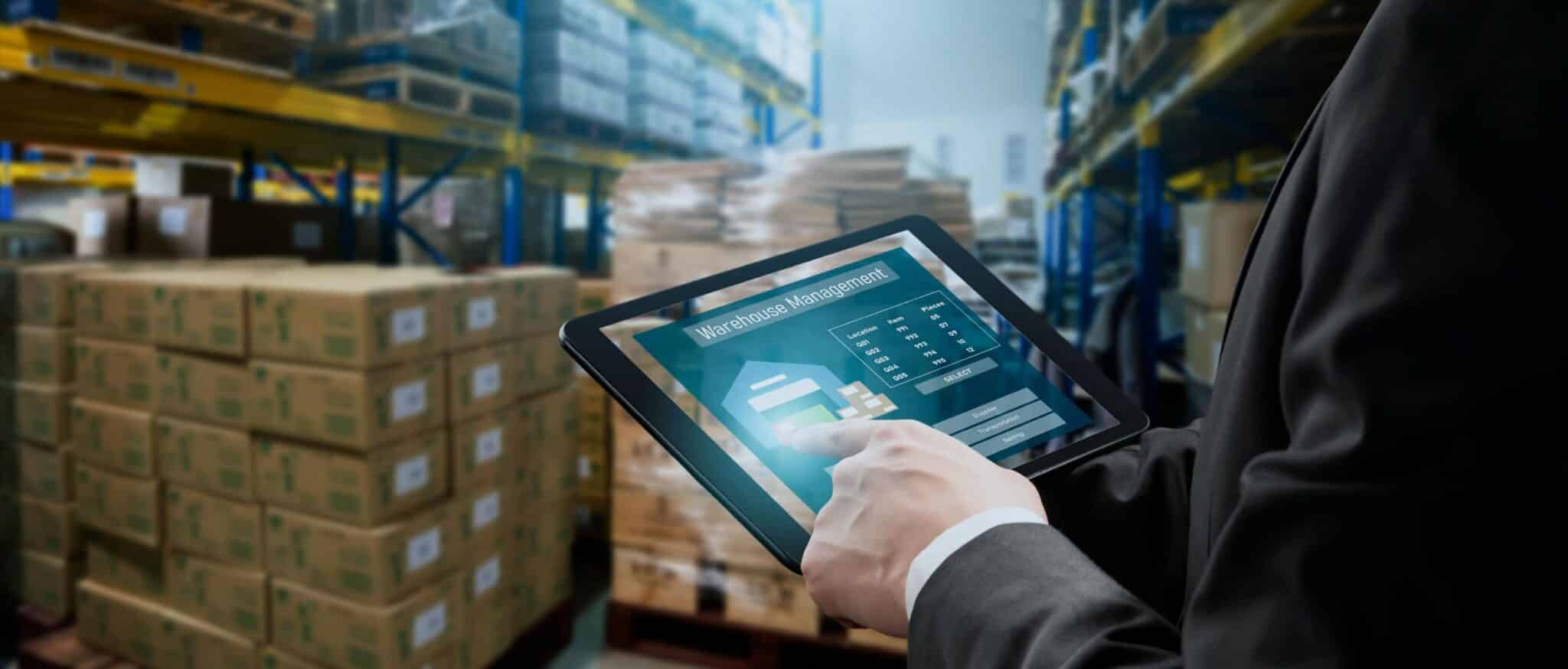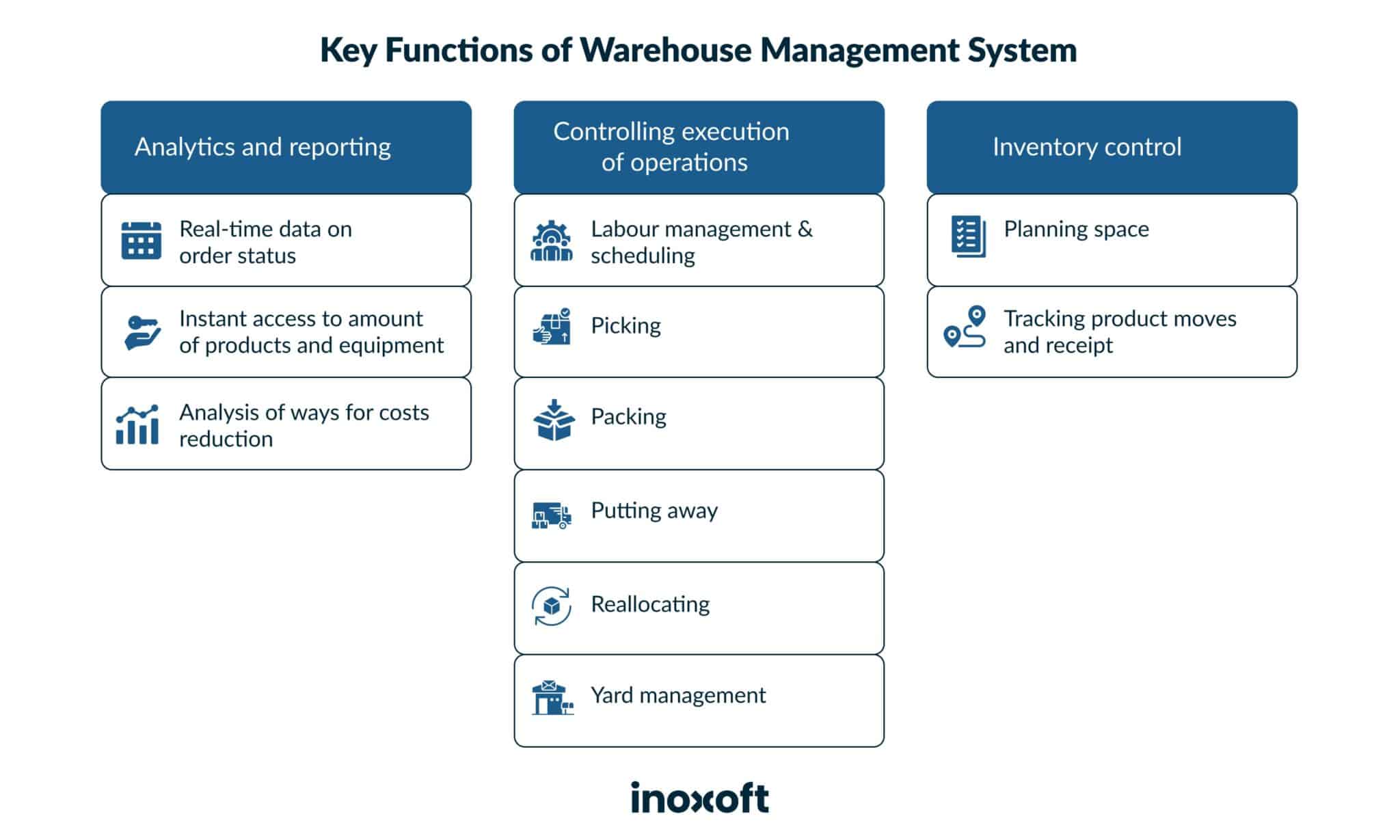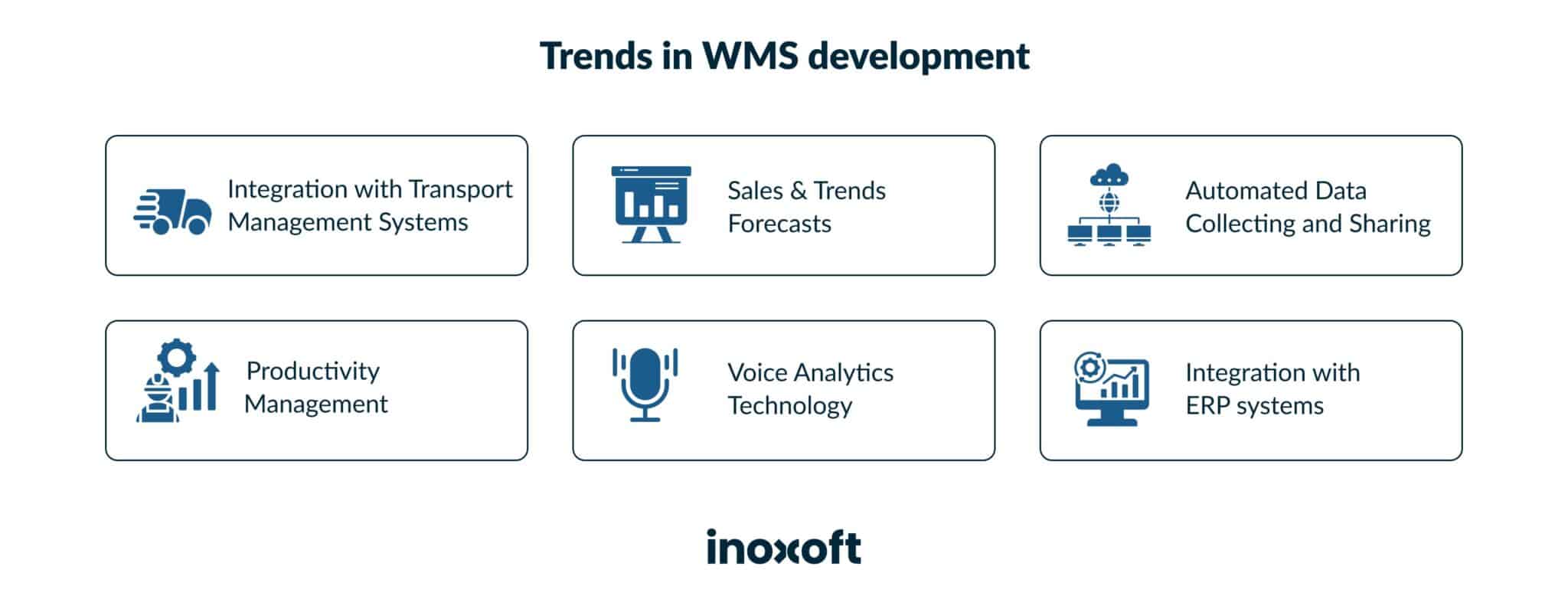Embark on a journey through the world of Warehouse Management Software (WMS), where efficiency meets innovation. In this comprehensive guide, we delve into the benefits, types, and features of WMS, exploring how this pivotal technology transforms warehouse operations. From streamlined inventory management to enhanced order fulfillment, join us as we uncover the essential elements that make Warehouse Management Software a game-changer in the logistics and supply chain landscape.
- Warehouse Management System Definition
- Types of Warehouse Management Systems
- Third-party logistics
- Integrated with ERP
- Supply chain management models
- Key Features of Warehouse Management System
- Inventory control
- Controlling the execution of operations
- Analytics and reporting
- Labor management
- Yard and Dock Management
- Benefits of Warehouse Management System
- Integration with TMS
- Warehouse automation
- Warehouse analytics
- Voice analytics technology
- Streamlining order management
- Transparency in inventory, delivery, and increased customer trust
- Increased productivity and efficiency
- Scalability as Your Business Grows
- Disadvantages of Warehouse Management System
- Long-term costs
- Level of expertise
- Customization
- Tight security
- Growing Warehouse Management Needs
- What Requirements Should the Software for Effective Warehouse Management Meet?
- Cost
- Compatibility with your existing systems or other systems
- Scalability
- Reporting and analysis capabilities
- Ease of use
- How Can We Help You?
- Final Thoughts
Warehouse Management System Definition
Warehouse management interconnects several terms as it is a chain of actions to move goods from the warehouse to the end customer on time. It closely interrelates with transportation management, intra-facility logistics (warehouse design), and equipment control. Furthermore, it’s also related to the application of technology tools. To understand what WMS is and what functions of the warehouse management system are, let’s go deeper into some of the key warehouse management tasks.
- Receiving is the physical receipt of goods, during which quantity and quality of goods are identified. Plus, the receiving reports together with compliance to order are compiled.
- Putaway – removing the material from the location of receipt (the dock), transporting the material to a storage area, and then moving it to an identified location. Also, it includes tracking the movement and time, when the material has been placed.
- Picking is preparing an order by pulling products from storage areas to complete a customer order.
- Packing deals with the protection of goods. That is packaging them and preparing a container for shipment.
- Replenishment is moving inventory from secondary storage areas into fixed storage locations.
- Shipping involves the tasks of packaging, marking, weighing, and loading goods for shipment.
From the manufacturer, raw materials travel to the enterprise warehouse. There they are documented, received, and placed. Once the product is ready, it remains in the warehouse of the firm that produced it. What’s more, items may reach thousands in number, so they need to have a barcode or RFID tags that can be scanned.
Workers receive orders from retailers. So, these orders have to be accepted, information gathered, and indicated within WMS. Order is fulfilled through a process of finding it among thousands of boxes and packages. And then through picking and packing, shipment, and recording delivery. All these operations come with electronic documents, barcode scanning, using a desktop to update inventory status in the warehouse, etc.
What does WMS mean? Nowadays warehouse management systems perform not only the basic functions of organizing and managing operations above. Yet, they also accomplish a lot more functions that help business executives conduct processes transparently and effectively. Additionally, we often need WMS to establish better security and privacy in supply chain management as they deal with filling documents and data share and storage.
WMS software is critical to managing and conducting operations automatically from one place where workers can easily track product movements and be aware of what’s in stock and what’s out, know customer details, etc.
Types of Warehouse Management Systems
Generally, there are 3 key types of warehouse management systems:
Third-party logistics
Third-party logistics are the ones that mostly use standalone systems. They offer warehouse management functions and can conduct operations easily.
Standalone systems have to be flexible and easy to use, compatible with scanners and terminals, and support different time zones, geographical areas, languages, and groups of employees. What’s more, they are great for managing LTL/TL rating which is less-than-truckload shipping or less-than-load and means the transportation of relatively small freight.
Integrated with ERP
If your enterprise needs advanced WMS with renewed functionality, barcode scanning integrations, possibility to reduce expenditures and make solutions that suit different types of industries, then it is better to develop customizable inventory solutions.
Such systems allow not only to conduct of inventory audits but transmit secure and protected data into ERP databases, which increases clarity across all supply chain processes. Integrated warehouse systems are definitely more elaborate and can also deal with Customer Relationship Management and human resources allocation to different tasks. Finally, this variant of WMS is a perfect investment for those who aim at scalability and want to centralize all operations and processes into one software solution.
Supply chain management models
Such systems help to manage everything from vendor collaboration to evaluating business processes. At the same time, they automate inventory audits, product operations, and material delivery.
Key Features of Warehouse Management System
The core functions of a warehouse management system lie in three directions:
Inventory control
Inventory management is a beneficial function and the principle with which the first WMS started. Moreover, it helps to organize operations effectively and have accurate information on when and which products were received, shipped, packed, packed, and delivered.
- Planning and managing inventory space
- Tracking and allocating inventory
- Planning and monitoring product moves
- Managing and scheduling receipts and putting away activities
Controlling the execution of operations
- Allocating personnel to areas and managing labor
- Tasks tracking and assignment, and providing a necessary toolkit to monitor and track the state of receiving, picking, packing, putting away, reallocating
- Scheduling of operations
- Yard management
Analytics and reporting
- Analytics on the number of stored products, in and out-of-stock information
- Accurate reporting of receipt and delivered goods
- Tracking equipment
- Reporting on order status
Labor management
It focuses on optimizing and managing the workforce within the warehouse. It aims to ensure that labor resources are used efficiently, and tasks are completed in a timely and cost-effective manner.
- Workforce Scheduling: The system helps in planning and scheduling labor resources based on the workload and priorities.
- Task Assignment: Labor Management assigns specific tasks to individual workers based on their skills, availability, and the priority of the task.
- Performance Tracking: The system monitors the performance of each worker by tracking their productivity and accuracy.
- Reporting and Analytics: The feature provides data and reports on workforce productivity, labor costs, and other key performance indicators, allowing warehouse managers to make data-driven decisions to optimize labor resources.
Yard and Dock Management
It’s another integral component of a WMS that focuses on the efficient management of the receiving and shipping areas of a warehouse. This feature helps in optimizing the flow of goods in and out of the facility, reducing congestion, and minimizing delays. Key elements of Yard and Dock Management are:
- Appointment Scheduling: The system allows for the scheduling of appointments for inbound and outbound shipments, ensuring a smooth flow of goods and preventing congestion at the loading docks.
- Yard Planning: It assists in optimizing the layout of the yard, guiding truck drivers to available parking or docking areas, and helping staff locate specific trailers.
- Trailer Tracking: The system tracks the location and status of all trailers and containers in the yard, providing real-time visibility into available capacity and the status of inbound and outbound shipments.
- Load Optimization: Yard and Dock Management can help plan the optimal loading sequence, ensuring that products are loaded onto trailers in the most efficient order, and reducing loading and unloading times.
- Notification and Communication: The system often includes automated notifications and communication tools to keep all stakeholders informed about the status of shipments, delays, and any issues that need attention.
Warehouse management software development has gained new functions to help organizations track their products, status of orders, and equipment. Firstly, to reach higher speed in delivery goods and operations. And secondly, to reach better customer satisfaction and be competitive on the market.
Read more: build a custom ERP software for shipping
Benefits of Warehouse Management System
What are warehouse management system benefits? Warehouse management software has seen a lot of advancements since the application of AI, the Internet of Things and robotics, new integrations, and automatized processes. Anyhow, the key warehouse management software benefits offered to warehouse managers and technicians nowadays are:
Integration with TMS
Transportation and warehouse management systems often remain separate due to the different functions they perform. However, there are several reasons to integrate both into cutting-edge solutions. Without any doubt, transportation management system benefits are valuable and they certainly can scale up existing WMS solutions:
- effective and on-time route planning
- tracking and reduction of costs spent on fuel and equipment
- improving fleet and freight management
- increased efficiency of the supply chain
The benefits of a warehouse management system double the effectiveness of delivery of goods, tracking delivery in real-time, avoiding shortages of transport means, and predicting risks in transporting goods. And, thus, warn other departments of possible delays or barriers.
Warehouse automation
The first warehouse management systems of the late 1990s and early 2000s were designed to keep track of stocks and there was a lot of paperwork to do. With technology, warehouse automation has gone through a myriad of transformations.
Nowadays, we have extended Warehouse Management – a modern automated warehouse management system. Defined by Wikipedia as an Extended Warehouse Management product, it is an integrated software platform for flexible, automated support for processing goods movements and for managing inventory in the warehouse.
Manual paperwork, the last century’s history, is now substituted with electronic data interchange (EDI). Information on goods and vendors is now backed up and can be easily accessed in real-time, altered, and edited. It ensures the safety of documents and protects against mistakes.
Warehouse management systems also automatically generate Advanced Shipping Notices. It is a document about the delivery of goods that includes physical characteristics of shipment, package, details about transportation, carriers, and dates.
Warehouse analytics
The system can calculate and define an accurate strategy for when and which products we will receive first and which ones will sold. Accurate forecasts allow sales to increase and avoid loss of money basing inventory on current sales and trends. The objective of smart WMS is to reduce the risk of a shortage of goods that are in demand.
Then, WMS helps track FIFO, a method that stands for first-in, first-out order. Obviously, it is a method to distribute the oldest items in the stock, and the LIFO method, which is last-in, is a first-out strategy that says that the most recent products to come are the first to leave.
WMS also has a function to integrate data with ERP that contributes to acknowledging and updating inventory data and distributing it across enterprise departments to make better decisions on sales.
Voice analytics technology
We use NLP and AI to record personnel verbal speech and transform it into instructions, send delivery confirmation, and automate the manual work of warehouse personnel. Even though these advances began to appear in the WMS software development market, they offer excellent hands and eyes-free technologies that boost working capacity per unit of time.
Streamlining order management
Updated information on orders, vendors, customers, and returns, order processing records is a must-have in warehouse management. Indeed, data on orders should be transferred smoothly and transparently. Furthermore, there is a machine-to-machine technology that enables the sharing of data between computers and WMS.
Big data and analytics help to define trends and replenish stocks with items, accurately predicting orders. During an emergency, the stock will be prepared to satisfy the necessary level of delivery of certain items and will fulfill all the orders on time. Mobile scanning devices and WMS with intuitive interfaces help a lot in accepting an order and notifying customers on delivery. Machine learning is also useful for defining how long the processes can take, what the temperature is in the storage, what is the location of items, and how to manage warehouse space wisely.
Transparency in inventory, delivery, and increased customer trust
Omnichannel supply chain management deals with partnerships with different channels. Workers can easily track what orders are placed, processed, shipped, and what orders are in route. There is a need to take into account every square meter and effectively manage the placement of specific goods that can be easily harmed or need to be delivered quickly. That’s why WMS should conduct Cycle Counting or Inventory Audits indicating the number of items within a warehouse.
WMS also contains and receives Proof of Delivery (POD) Information by the carrier containing the name of the person, who signed for the shipment. And, also the time and date of delivery, and other shipment delivery-related information.
Increased productivity and efficiency
The use of Advanced Warehouse management systems leads to a reduction in labor costs by up to 30% as automation increases labor productivity. Besides, modern warehouse management systems have very intuitive interfaces, automatic fill-in of information, warning and push notifications, and integration with other systems. Automated processes at warehouses can improve safety at the workplace by offering:
- a real-time view of inventory
- boosting accuracy in orders
- reducing human mistakes
Scalability as Your Business Grows
Here are the key ways in which scalability within a WMS benefits businesses as they experience growth:
- Accommodating Increased Inventory. As a business expands, it often entails a growing inventory volume. A scalable WMS can easily handle a larger number of stock-keeping units and accommodate the storage of more products. This ensures that your warehouse can continue to manage the increased inventory without disruptions or inefficiencies efficiently.
- Expanding businesses may require multiple warehouse locations or distribution centers. A scalable WMS allows for the seamless integration of new locations into the system. This means you can efficiently manage inventory across different facilities, maintaining visibility and control over your entire supply chain network.
- Scalable WMS can seamlessly integrate with other software and systems, including Enterprise Resource Planning (ERP) systems, Transportation Management Systems (TMS), and e-commerce platforms. This allows for the efficient flow of data and information between different parts of your business and promotes better decision-making.
- Scalable WMS can seamlessly integrate with other software and systems, including Enterprise Resource Planning (ERP) systems, Transportation Management Systems (TMS), and e-commerce platforms. This allows for the efficient flow of data and information between different parts of your business and promotes better decision-making.
- WMS can handle growth and also helps manage costs effectively. You can invest in the system’s expansion as needed, rather than overcommitting to a comprehensive solution from the start. This results in cost savings, as you only pay for the resources and features you require at any given time.
Disadvantages of Warehouse Management System
You have learned more about the positive features of WMS. However, it’s crucial to take into account the disadvantages of the warehouse management system. Let’s have a look at some of them.
Long-term costs
Data maintenance can be expensive for small and medium-sized companies, and it is required for most of the companies. The larger your project is, the more costly it becomes to implement WMS.
Level of expertise
Usually, the processes of implementing a system can be challenging. That’s why you need a team of professionals to deal with warehouse management system implementation. To execute all the operations right, you have to have the right resources to handle the software.
Customization
Many businesses do not finish their customization processes, because customization requires a lot of your time and money. As a result, future upgrade implementation can be complicated.
Tight security
One more aspect of the successful implementation of WMS is safeguarding your inventory. If you protect your inventory, there will be no threat of thieves for you.
Growing Warehouse Management Needs
The COVID-19 pandemic impacted transportation and logistics heavily. However, after the quarantine, the companies will certainly accelerate and rethink the way they organize their work. Competition for speed and customer attention will be more severe. Also, cross-docking transportation can increase, fulfilling direct delivery to consumers.
Automation is a WMS trend that creates a step-by-step guide of what a worker has to do with an order. Following directions of a system, a worker can also ask to show empty locations or print license plates (a so-called LP number) that are later scanned and backed up in the system. Then, the next steps are easier for drivers of vehicles, who can easily find the items via scanned numbers among rows of shelves and aisles, see necessary information and be aware of defined areas for these in the warehouse.
Materials managers can easily conduct their inventory work in WMS. Salespeople go into the system to create an order on thousands of items, allocate them properly, and schedule processes, allowing other sales representatives to see and monitor the current state of products.
RF scanning is the greatest benefit most warehouses depend on. In fact, scanning helps to allocate items to a bin and cross-check when a single customer orders several items. If anything goes wrong, the inventory and accounting departments receive a notification. Thus, billing should change or mistakes should be corrected.
All in all, warehouse management systems anticipate automated processes, application of analytics, and AI to accelerate the speed of delivery and reach maximum customer satisfaction.
What Requirements Should the Software for Effective Warehouse Management Meet?
To provide quality warehouse management system functionality, there are some requirements that software should meet for effective warehouse management. Let’s check some of these requirements.
Cost
The cost of WMS varies depending on its features. There are different types of WMS too, and each has its own cost.
Compatibility with your existing systems or other systems
WMS must be compatible with your other systems, like ERP or TMS. This compatibility helps streamline warehouse operations.
Scalability
The right WMS should scale with your business during its growth. If you follow this recommendation, you won’t have to replace the system in the future.
Reporting and analysis capabilities
For you to track and analyze key performance indicators, WMS needs to have reporting and analysis capabilities.
Ease of use
For your employees to effectively use the warehouse system, it should be easy to use and understand. This way you will need less time to learn and more practice.
How Can We Help You?
Inoxoft is an education software development and logistics software development company that specializes in automating your business processes. We engage in warehouse management system development and develop quality apps with a lot of trendy features.
Inoxoft’s purpose is to match the deployed software to the company’s values and clients’ business needs. Our expertise in warehouse process management, logistic management software, and transportation management systems expand upon:
- Barcode scanning
- Cloud capabilities
- AI integration and Machine Learning
- Data Analytics
- IoT and connected devices
Inoxoft designs customized solutions for every client. We implement AI in logistics so you could:
- Monitor supply chain
- Explore cloud capabilities
- Advance with freight and transportation management systems
- Integrate with a customer relationship management system
- Engage in enterprise resource planning
- Enhance production planning
- Benefit from inventory and warehouse management system advantages
- Predict and plan your budget
We will tell you more about centralized distribution system, IoT in logistics and enterprise system benefits.
The benefits of wms we provide are numerous. Contact us to receive a detailed consultation on our services. Partner with us to develop innovative exciting solutions for the Logistics and Supply Chain industries! Our clients recommend Inoxoft as the top software developer on the market. You can view their comments here. Or, get to know everything about our solutions here.
Final Thoughts
The article has spoken about the advantages of warehouse management systems and the benefits of warehouse management software you will get if you decide to automate your business.
The benefit of WMS is truly extensive. Mainly, all the processes become automated, analytics can be applied to and give out positive results. Artificial intelligence is used to make product delivery as fast as possible. Warehouse workers will unquestionably be more productive and experience fewer manual errors. And, your customers will be beyond satisfied with the provided services.
Frequently Asked Questions
What are the benefits of warehouse management system?
The main benefits of warehouse management system are integration with TMS, warehouse automation and analytics, voice analytics technology, streamlining order management, transparency in inventory, delivery, increased productivity and efficiency.
WMS is often needed to establish better security and privacy in supply chain management as they deal with filling documents and data share and storage. WMS software is critical to manage and conduct operations automatically from one place where workers can easily track product movements and be aware of what’s in the stock and what’s out, know customer details, etc.
What are the main features of warehouse management system?
The main features of warehouse management system are inventory control, controlling the execution of operations, analytics and reporting.
What are the types of WMS?
The types of WMS are third party logistics, integrated with ERP and supply chain management models. Read the article to learn more about each type of WMS!










